|

|
Background
In the recent years, a paradigm shift in economic development strategies can be observed:
- from long-term planning to short-term action,
- from top-down to bottom-up,
- from government-driven to public-private partnership.
Therefore, Local Economic Development strategies have been adopted and comprise the following aspects:
- Driven by opportunity,
- Based on local resources,
- Business-driven,
- Not primarily addressing the main sector, but the motivated sector,
- Little emphasis on strategy as plan,
- Iterative process,
- Open and open-ended process (“perspectivic incrementalism”),
- Action learning,
- Main Role of LED Agents: Facilitation .
Figure 2: Where is PACA feasible
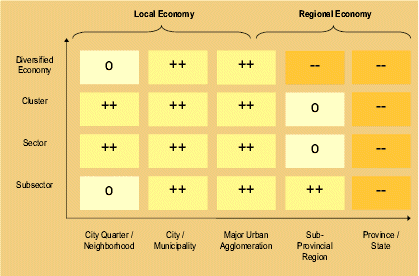
|
|

|
The sequence of activities using PACA
The Participatory Appraisal of Competitive Advantage comprises eight steps of implementation, which can be devided into three overlapping time spans, the PACA project, the PACA exercise and the PACA field work (compare Fig. 3).
The PACA Project:
An entire project applying the PACA approach, from the preparation initiation of the PACA, to the joint implementation of activities by concerned stakeholders.
Step 1: Preparation and organisation of the PACA project
This requires the identification of involved stakeholders, such as:
- Government institution(s)
- Private sector institution(s) (e.g. Chamber)
- NGO’s
- stakeholder forum
It is required to identify one stakeholder as a PACA Host, which
- mobilizes funds
- motivates other stakeholders
- creates a PACA team, consisting of
- 1 - 2 external consultants
- 3 - 5 local people
Figure 3: The sequenct of activities during a PACA project
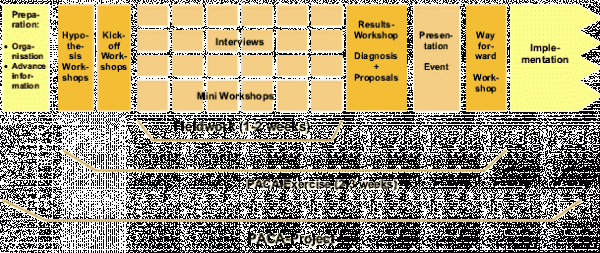
The PACA Exercise
The PACA team
- advances information to the stakeholders,
- identifies invitees for kick-off workshop, mini-workshops and interviews,
- organizes the kick-off workshop,
- coordinates the schedule for interviews and mini-workshops,
- organizes the presentation of results.
Organising a PACA Exercise:
In order to get organised, 8 - 9 weeks in advance the following activities have to be carried out:
- identify PACA Champion,
- define territory / focus,
- contract PACA Consultants.
5 - 6 weeks in advance:
- select PACA Team,
- plan details of organisation with LOCA Champion.
3 weeks in advance:
- book venues,
- invite people for kick-off, mini-workshops,
- make appointments for interviews.
Plan your resources:
- Making 90 contacts with an average of 2 phone calls and a length of 10 minutes per call results in 30 hours on the phone! Additionally, you have to spend time for marketing, correspondence!
- Check available publications (research, articles in papers and journals):
- Check statistics
- Main sectors in the local economy:
- What are their main competitors nationally and internationally?
- What is international good practice in promoting competitiveness in these sectors?
Step 2: The Hypotheses Workshop
Purpose:
- Get a shared understanding of the expectations in the PACA Team:
- on PACA
- on the location
- on possible proposals
- Make implicit opinions and prejudice explicit
- Create a base of reference for the next steps of work
Structure:
- Presentation on PACA
- Mesocard exercise 1:
- Clarification of open questions on PACA
- LOCA Consultants respond
- Mesocard exercise 2:
- What do we expect to be our findings?
- What may come out as proposals?
- Which LED activities are already going on?
Figure 4: Action plans can be developed using PACA from two perspectives
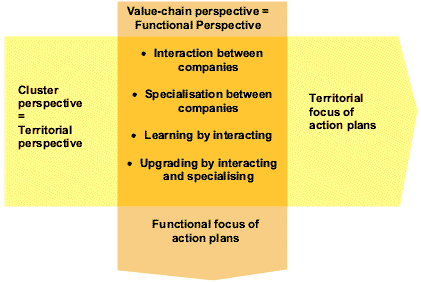
Step 3: The Kick-off Workshop
Invite 20 - 30 participants, e.g. via Business Chamber:
- Representatives of business associations
- Representatives of local government
- Representatives of leading firms
- Representatives of support institutions
- Local media
Make sure, you reserve adequate locality and prepare Mesocard materials before.
Purpose:
- Inform locall stakeholders about the PACA
- Raise information about the local economy
- hard information
- participants’ perception / interpretation of local reality
- Motivate participants to support the PACA exercise
- arrange appointments for interviews
- persuade colleagues to be available for interviews
Structure:
- Presentation of key concepts
- Michael Porter’s diamond
- optional: Systemic Competitiveness
- optional: LED
- Participants write Mesocard cards
- four diamond corners -- strong & weak points
- competitive advantage of the region
- vocation in ten year’s time
- Discussion of cards / observations / questions
- Explanation of subsequent steps
Photo 1: The PACA sequence as an open process is not limited to the single event of diagnosis of competitive advantage
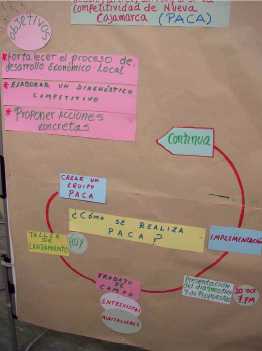
Step 4: The Field Work:
A. Interviews
- Identification of firms, institutions and individuals to be met
- during kick-off workshop, discussion with Chamber, local government, key informers
- structured interviews (“conversations”), usually with director/CEO/executive secretary, based on open questionnaire and qualitative methodology
- conducted by external and local members of PACA Team (2 - 4 persons)
- notes about observations, minutes, formulation of more hypotheses / reformulation of hypotheses
|
 |
Questionnaire vs. Interview Guidelines
Questionnaire:
- Closed questions (yes/no, scoring)
- Precise wording of questions is paramount
- Fixed sequence of question
Interview Guideline:
- Open questions
- Wording of question not defined ex-ante - depends on situation
- Interview dramaturgy depends on interviewee
Purpose:
- To understand the internal structure of the company / institution
- To understand how it fits into the local economy
- To gather its perception of the local economy
- To assess its willingness to participate in a LED initiative
- To motivate it to participate in a LED initiative
Structure:
- Intra-firm effort to improve competitive advantage
- Interaction with suppliers and subcontractors
- Interaction with customers
- Interaction with competitors
- Interaction with supporting institutions: training, R+D, information, finance, etc.
- Interaction with business association and Chamber
- Relationship with and percep-tion of local government
A good way to organize the interview is Michael Porter’s Five Forces Analysis Plus as shown in Figure 5.
Figure 5: Michael Porter’s Five Forces Plus
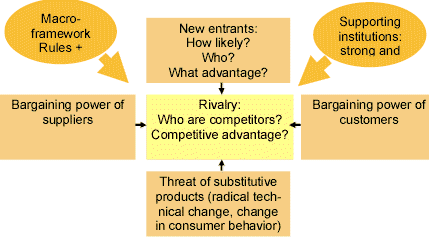
B: Mini workshops
- 5 - 15 persons with similar characteristics, e.g.
- particpants should come from the same industry and company-size (e.g. small garment firms, small food processing firms),
- participants should have a similar background (e.g. CEFE entrepreneurs, woman entrepreneurs, innovative firms),
- objective of the mini workshop is to evaluate the performance of the sector,
- Application of Moderation Method (Mesocards),
- Structuring tools like Porter’s diamond, Five Forces Analysis, Interaction Matrix and SWOT can be applied accoding to the demand of analysis.
- Which tools suit the Mini-workshop format?
An adaptation of Michael Porter’s Diamond is used
(compare table 1, figure 1 on page 2 and figure 6 next page),
- when a heterogeneous group is coming together,
- when the focuslies on locational factors,
- whendiversified landscape of supporting institutions.
Table 1: Issues regarding the explanation of the four corners of Michael Porter’s Diamond
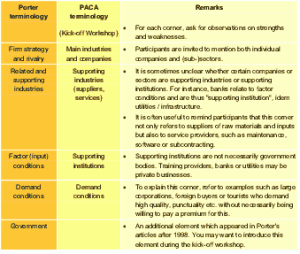
Figure 6: An adaptation of Michael Porter‘s “Diamond“
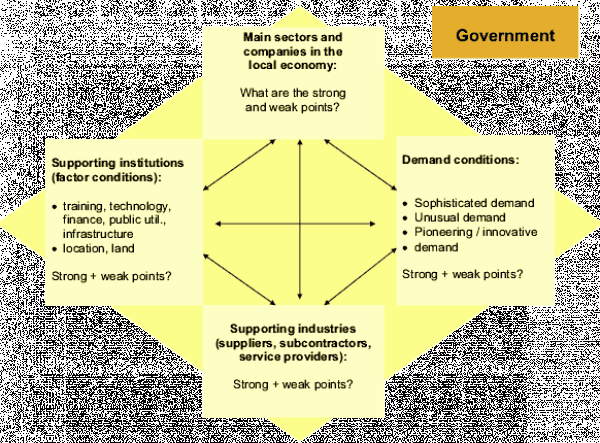
Michael Porter’s Five Forces Analysis (compare Figure 6) is helpful,
when the miniworkshop group is a homogeneous groop of businesses,
when only few supporting institutions are involved.
A Interaction Matrix is used, to identify benefits and advantages in relation to costs and risks for a possible cooperation (e.g. between IT firms and universities or supporting institutions / public sector). Figure 7 depicts a transaction matrix.
Figure 7: Interaction Matrix
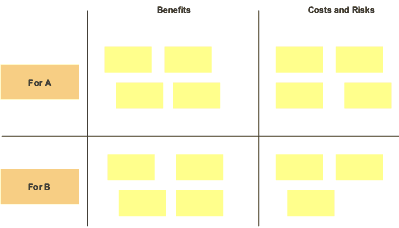
Step 5: Results Workshop
- Internal exercise of the PACA Team,
- verification / falsification of hypotheses,
- preparation of diagnostic (Mesocard),
- strong and weak points by industry / economic branch,
- strong and weak points of supporting institutions, associations, local government,
- prioritisation of observations (Pareto),
- verify: what were the proposals which came up during the field work, i.e. in interviews and mini-workshops?
- what are further proposals the team can come up with?
- verify: which proposals meet the following criteria:
1. realistic and viable
2. apt for quick implementation
3. potential for quick, visible effect
A closer look at the ”Three Criteria”
1. Realistic and viable:
Can this proposal be implemented with the locally available resources (motivation, know-how, institutions, funds,...)?
2. Quick implementation:
can you start planning for implementation next week?
3. Potential for quick, visible effect:
can you expect a visible effect within three months?
The PACA team defines a score between 1 (=no) and 3 (=yes) for each criterion. Multiply the three scores.
Figure 8: Typical constellations regarding business sectors in the local economy: Where to start?
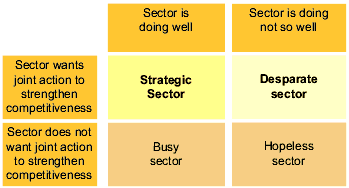
|
 |
Step 6: The Presentation Event
The format of the presentaion event is different from a normal presentation. Admittedly, there is a Powerpoint presentation
the Mesocard exercise breaks through the usual rituals.
Consider to give the presentation at an unusual location
to make sure that participants don’t forget the event.
Structure of the Presentation Event:
- Presentation of concepts, findings and proposals,
- Mesocard exercise with audience,
- optional: additional activities with interested participants.
Presentation of concepts, findings and proposals:
- explain the concepts and the methodology used (Powerpoint) ,
- present the diagnostic (Powerpoint),
- present the proposals (Powerpoint).
Discussion of findings and proposals:
- distribute cards and markers among the participants, explain the Mesocard rules (1 idea per card, write legibly),
- ask the participants to write down their observations, questions, criticism and proposals,
- stick the cards to the wall, discuss them with the participants.
Management of expectations
Do not create unrealistic expecations:
- do not formulate proposals which are unlikely to be implemented!
- don‘t promise activities which will overwhelm your capacity!
- don‘t promise that you will solve the local stakeholders‘ problems!
- don‘t give the impression that you come with a big bag of money!
- limit the number of proposals, and mention who will be in charge of them!
Step 7: The Way-forward Workshops
Purpose:
- Define priorities, activities and responsibilities for implementation and monitoring
- Separate workshops around each proposal / sector
Format:
- Explanation and clarification of the meaning, context and background of monitoring
- Mesocard: How can we implement monitoring?
- Transforming the Mesocard result into a mindmap
- Mesocard: What are the obstacles and risks in the implementation of monitoring?
- Planning exercise (Mesocard): How will we implement monitoring?
Step 8: Implementation
- creation of working groups for given sectors (e.g. software, tourism) around project ideas (e.g. paleontology center),
- working groups initially operate independently,
- coordination between activities, initially informally, later, as complexity increases, via a Stakeholder Forum or similar fora.
How to know that you do PACA in the right way?
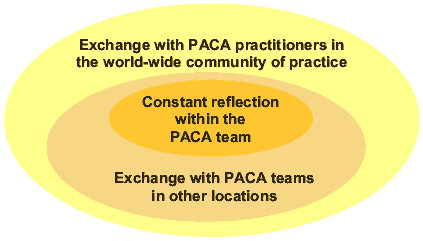
PACA is currently implemented in:
- Armenia
- Bolivia
- Bosnia-Herzegovina
- Brazil
- Chile
- Colombia
- Dom. Republic
- Ecuador
- Ghana
- Honduras
- Indonesia
- Macedonia
- Montenegro
- Namibia
- Nepal*
- Nicaragua
- Peru
- Serbia
- South Africa
- Sri Lanka*
- Thailand
- Vietnam
* in Sri Lanka and Nepal, the methodology PACA is renamed as LOCA (Local Competitive Advantage) in order to avoid negative connotations
|












